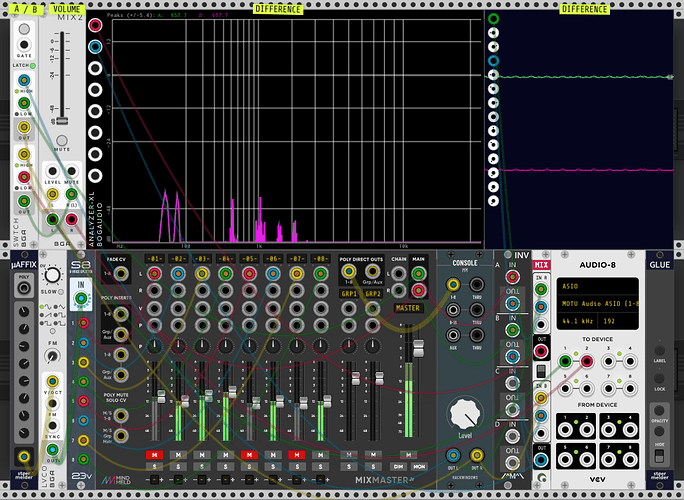Great stuff happening here, i been sleeping on this thread 
I thought there was a GREAT difference in the sound ( I could also see it on the scope), but then I found out that the AUX channels were added to the main tracks. When I checked the “Don’t send tracks when grouped” in the Direct outs I could barely hear/see any change 
Yes haha… turns out i had done the same thing! I had my kick and hats sent to groups so they were being doubled up - no wonder they cut through the mix…Doh!
After turning the groups off, the effect was definitely much more subtle and spread more evenly across the frequency range (although with still a little emphasis on the highs perhaps). When using the phase cancellation it mostly seems like a subtle distortion effect now.
Regardless of whether the particular sound of Console6 floats your boat or not, what has me most excited about this though is the new possibilities it opens up, particularly if @n0jo adds some more sound colour/flavour options to console. We now have a very neat and integrated way of adding colour to MixMaster’s clean sound.
Back when we were making EQMaster, a multi-track saturator/colouring module was definitely an idea that popped up, so very happy to see this.
I would leave the level control. In my short testing, I have found that I need to lower the output level about 25% to keep levels from getting too hot. I just want to say that I agree with @steve that the module adds a nice, but subtle, effect.
Has anyone measured the difference with Interstage as well? I want to believe in the magic.
Here is another development build including the suggested panel adjustments and the option to sum the poly channels on the individual outs:
Yeah, I noticed too that it can get a bit spiky on some sources. This happened with Console6 I suppose? It’s less forgiving than PurestConsole but also more pronounced and possibly a bit quirky.
I think the jury is still out on gain calibration with this one, which is why I’m really grateful for the testing that’s going on. To me the question is not so much about the summing effect itself (which has gone through many ears and analyzers over the years), but rather the amount that is applied here by the module.
I agree it’s probably best to mix into it to avoid potential issues later on.
There’s some amazing potential with this interesting synergy of modules.
Let’s call this “RackMeld MixConsole” for now:
16 channel mixer with built-in tape saturation and analogue console summing, plus a fully-featured mix-checker, headphone spatializer, and cutting-edge output dither.
Obviously, one could go way, way further. I just wanted to show thanks to the developers in question for ushering in a very interesting new set of functionalities to the Rack environment.
Cheers! ![]()
Awesome melding of worlds!  The small option we added to solo the chain inputs has been submitted to the library, so it should be release soon.
Live long and prosper!
The small option we added to solo the chain inputs has been submitted to the library, so it should be release soon.
Live long and prosper! 
It’s an awesome thing to have such inspiring and fun music tools to work with - hence my thanks to you!
That solo chain input idea is a really good one, it takes away nothing from your feature-spoiled masterpiece, and even outside of this Rackwindows context, could be helpful for many things… patch de-bugging, etc.
Happy Friday 
What’s the benefit of sending the signal back into MM’s Chain input and out through Main. Wouldn’t going from Monitoring straight to your audio module do the same or does MM add something to the signal here?
If I’ve understood the question correctly, I can’t speak directly on what future updates might provide, but I suspect it is related to metering of the chain inputs.
Sending the signal back into MM allows the master fader and VU meter to be used, and also some other internal master options, like DC blocker, and soft clipping.
They added a mode to Mixmaster such that you can use the direct outs -> console -> chain input as a polyphonic insert path. So you get the same output as you would direct from monitoring, but you the master fader, master level & dim/mono/mute switches
that’s nice but…tape consumes almost 50 percent of cpu in that kind of connection.
I know that @n0jo is conscious of CPU efficiency. We have spoken recently about some possible optimisations to his modules that may or may not work well, further down the line.
Please, don’t overlook what Monitoring brings to the table also 
Monitoring is a nice module indeed for those who don’t have dedicated monitoring FX somewhere in their OS behind the curtain (I personally have Pedalboard + Asio link pro for eq correction of both monitors and cans and some crossfeed and even room sim for headphones ;-)). I mean Monitoring is for the different purposes as having other pair of monitors, auratones and etc. of course but still needed to compare with commercial tracks to understand what’s going on. Still figuring out how Peaks translates those squashing transients btw 
Yeah, I use the good ol’ Reference 4/Can Opener 3 combo personally. Monitoring is great as a versatile mix-checker, even with those other monitoring tools available. Also things like “phone” and “aurat” make for pretty cool channel effects, while blending small amounts of “subs” or “slew” can work like a really powerful EQ.
Quick Q: Does anybody know if Audio-8 dithers it’s outputs?
I’ve been putting Tape in it’s own bus so thatI can get it late in the signal chain on the basis that whatever effect recording to tape has is the last thing that happens (but I don’t actually want it on everything). I don’t really know what I’m doing though.

